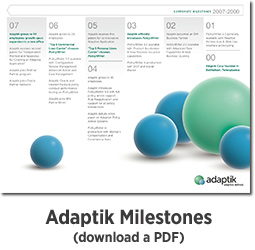These days we hear a lot about upstart entrepreneurs fresh out of college (or even high school) who dream up some new app or technology and turn an entire industry on its ear.
But in the B2B world, it’s much more likely for a disruptive technology to be introduced by seasoned insiders. These experts have paid their dues working in, on and around entrenched legacy technologies and processes, learning the hard way from the inside out. Soon enough, these visionaries, driven by frustration, eventually start asking that dreaded question: “Why?”
Unfortunately, regardless of the industry, the “establishment” rarely appreciates being asked, “Why?”—especially when the answer uncovers unpleasant (and often costly) truths.
The truth is that that “disruptive” means “change.” And if you’re the 8oo-pound gorilla, change is a baaaaad thing.

That was exactly the situation in the insurance administration software industry 14 years ago. Two colleagues—experienced, smart, dedicated, and full of “why”—decided to leave the security of their jobs and start their own software development company.
And so Dr. Tamer Uluakar and John Pettit founded Adaptik Corporation. Adaptik’s flagship product, PolicyWriter, is an insurance policy administration system that makes it fast and affordable to for large insurance companies to keep up to date with the rapidly changing needs of their agencies and clients. In other words, it enables insurance carriers to save lots of money and provide better services with dramatically faster speed to market.
Disruptive: It’s a Good Thing
I’ll spare you the technical details of how it works, and instead give you an example: Let’s say that you’re an insurance company that just got hammered with claims because of a big hurricane in south Florida. You want to hedge your losses against future disasters, so you decide to give a discount to policy owners who install storm shutters.
Unfortunately, you have a legacy policy administration system in place—one whose code is so complex and kluged together that it’s all but locked in stone.
So what would it take you to add that storm shutter exemption? At least three months, plus a dedicated coding team and entirely too much money.
And how long would it take using Adaptik’s PolicyWriter, which was built from the ground up to be flexible and adaptive? About 10 minutes using a drag-and-drop admin panel.
That’s “disruptive” in a nutshell.
Shouting from the Rooftop
We first started working with Adaptik in 2009. They had already been in business for nearly 10 years, steadily fine-tuning and improving PolicyWriter. But Adaptik was still largely unknown in what is a very conservative and change-resistant industry.

Our first goal was to raise the visibility of the company and establish its credibility. We started with a nearly two-year integrated rebranding effort that included a new brand messaging, new website and new logo, plus a series of white papers and blogs, regular trade advertising, PR and more. And it paid off.
We all remember the day several years ago when we got an excited call from our Adaptik contact. She was staffing the corporate booth at one of the big insurance industry tradeshows. This was the first time Adaptik had exhibited, but people were coming up to the booth and saying, “Adaptik—I’ve heard of you guys! Wow, you’re everywhere!”
Gaining Traction
Early in the rebranding efforts, Adaptik’s established competitors simply ignored them. Then these 800-pound gorillas tried dismissing the technology. And then, in the ultimate backhanded compliment, their competitors started “borrowing” the messaging that we helped Adaptik develop. Each time, Adaptik’s messaging responded and evolved.
Throughout all of these efforts, the two founders have stayed above the fray, confidently leading their ever-growing company to improve and innovate. And in the process, they have proved beyond a shadow of a doubt that “Why?” is the exactly the question that every company, no matter how big, should never be afraid to ask itself.




